Apple's iPhone 4: Thoroughly Reviewed
by Brian Klug & Anand Lal Shimpi on June 30, 2010 4:06 AM EST- Posted in
- Smartphones
- Apple
- iPhone 4
- Gadgets
- Mobile
Performance
When the 4 was announced, my curiosity (and perhaps yours as well?) was about the flavor of Apple’s A4 SoC inside the phone. The rumor was that the A4 in the iPhone 4 had a full 512MB of memory, compared to 256MB in the iPad’s A4. iFixit took an iPhone 4 apart (with relative ease I might add) and confirmed the presence of 512MB. Look at the A4 in this picture, the Samsung part number on the right edge of the chip starts out K4X4G. The K4X denotes a Samsung mobile DRAM and the 4G refers to its density: 4Gbit or 512MB.
More memory should mean a smoother multitasking experience on the iPhone 4. Remember that iOS 4 keeps all fast task switching enabled apps resident in memory even after you’ve switched away from them. They are only kicked out of memory if you run low or if you force quit them. With more memory you should be able to keep more apps in memory without unwillingly forcing them out. The 512MB of RAM should also give the OS more breathing room in lighter multitasking scenarios, a problem many are already seeing on the iPhone 3GS running iOS 4. In practice the 4 is smoother when running iOS 4. There are still some hiccups but not as bad as on the 3GS, and definitely not as bad as on the 3G. The OS was clearly designed with the iPhone 4 as the performance target.
The big question that remains is what clock speed the iPhone 4’s A4 is running at. The assumption was 1GHz however Apple was very careful not to mention clock speed, unlike at the iPad launch. Saying nothing usually means there’s nothing good to say.
I ran a whole bunch of benchmarks on the iPhone 4 and the iPhone 3GS running iOS 4 to try and figure out what CPU speed we might be dealing with. The early reviews imply that the A4 in the iPhone 4 is running at a speed greater than the 3GS’s 600MHz, but slower than the iPad’s 1GHz. Let’s try and find out what it’s really running at.
We’ll start with the real world tests, first SunSpider. A javascript performance test this benchmark is completely network independent but it measures the performance of the browser as well as the underlying hardware. It is small enough to make memory size differences negligible so between the two iPhones we should be seeing a pure CPU comparison:
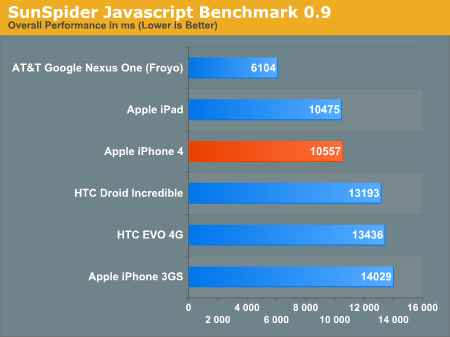
The iPhone 4 manages a time that’s 25% faster. Note that this test is just as much about the software stack as it is about CPU/platform performance. The Froyo update makes the Nexus One ridiculously fast in this benchmark. It just shows you how much room there is to improve performance on these Android handsets. The next leapfrog is going to be once the entire Android world moves to 2.2.
Next up is the Rightware BrowserMark. This test combines JavaScript and HTML rendering performance:
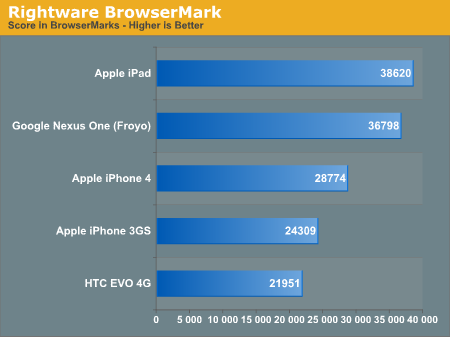
BrowserMark spits out an overall score but with no indication of what the score actually means. In this case we’re looking at 18.4% better performance than the iPhone 3GS. The iPad is 34% faster than the 4, which supports the theory of the A4 running at ~750MHz in the new iPhone.
There's also the possibility that the A4 CPU clock varies depending on load and other factors but the run to run consistency in all of our tests seems to indicate otherwise. We also can't ignore the fact that the iPad and iPhone now run vastly different OS revisions. In some cases iOS 4 actually takes a step back in performance compared to iOS 3.2. That undoubtedly makes the iPad vs. iPhone 4 comparison about much more than CPU performance.
Froyo's improved Javascript performance sends the Nexus One nearly to the top of the list here, only bested by the iPad. While Apple has definitely improved performance with the iPhone 4, it seems that it will only take a software update for Android phones to surpass it.
To measure web browsing performance I downloaded a bunch of different web pages and saved as much of them as possible locally on a server. I used WiFi on all of the devices to connect to my local server and timed average load time. I repeated the test at least 3 times and threw out any unusually high or low numbers. Performance was from a clean restart with no additional programs running in memory.
Note that these numbers aren't comparable to other reviews as we've updated software versions on two of the phones. The iPhone 3GS is now running iOS 4 which resulted in some numbers going up while others went down. And the Google Nexus One is running the officially released build of Android 2.2, codenamed Froyo.
What these tests should show is the overall performance of the platform when all network bottlenecks are removed. Obviously hiding in a tunnel under a lead umbrella will make any phone slow, but we’re looking at peak performance here.
The first test is the new AnandTech front page. Here we’ve got tons of images and HTML, meaning we’re stressing both bandwidth and code parsing speed.
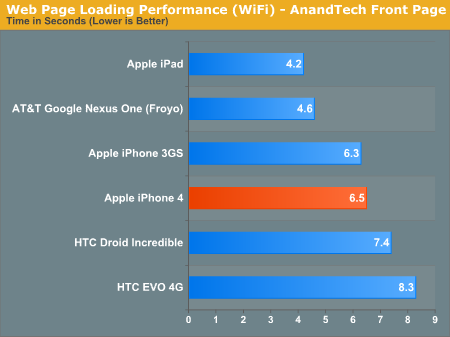
The iPhone 4 is no faster than the 3GS (actually slightly slower, but we'll chalk that up to timing variance) here. The Froyo update to the Nexus One makes it lightning quick, almost as fast as the iPad in our first test.
Next up we have the first page of our recent Zotac XBOX HD-ID11 review. The balance shifts from tons of images to more HTML processing:
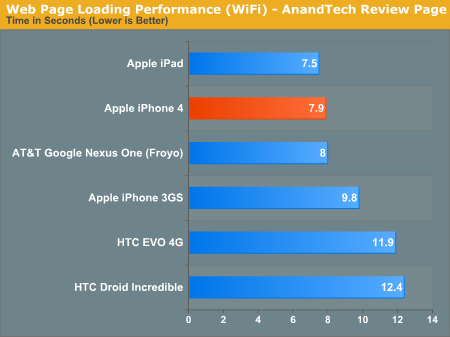
Here we see more of what I expected: the iPhone 4 is around 25% faster than the 3GS running iOS 4. Android 2.2 running on the Nexus One is basically as fast as the 4.
Using our Print this Review function, this next test loads our entire 2010 15-inch Macbook Pro review. While the other two tests had some flash ad content, this one is completely devoid of it so the HTC phones shouldn’t be penalized:
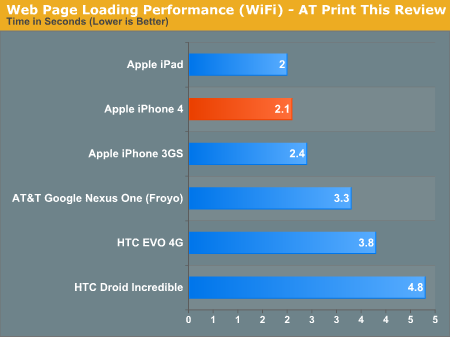
Here the iPhone 4 is 11% faster than the 3GS and about the speed of the iPad. There are other bottlenecks at play here so we don't get further performance scaling. The Froyo update helps the Nexus One a bit but the iOS devices are still quicker.
Our most intensive test is up next with a load of the Engadget front page:

The Nexus One is ahead of the 4 once more with its Froyo update. And the iPhone 4 is 34% faster than the 3GS.
Our most CPU bound test is up next. I put together a custom page with a ton of tabular content and a single page copy of our 15-inch MBP review to make the load take some time at least.
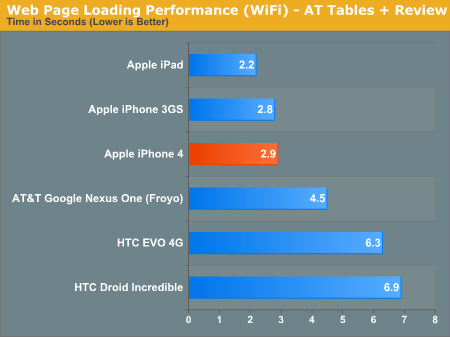
Surprisingly enough there's no difference between the 3GS and the 4 here, perhaps my test is less CPU bound than I thought. Froyo improves the Nexus One's performance a little bit.
Low Level Synthetic Tests
If we assume that we’re mostly CPU bound in all of these cases (a fair assumption given how fast Atom can run through all of these tests), then we’d be looking at a ~750MHz clock speed for the iPhone 4’s A4 assuming no other architectural changes. That’s actually a pretty big assumption. The A4 is widely believed to be a 45nm SoC using an ARM Cortex A8. At 45nm there should be room for a larger L2 cache than what was used in the iPhone 3GS’s SoC.
Perhaps some more synthetic tests will help us figure out what’s going on. I turned to Geekbench, now available in an iOS version.
Geekbench spit out a number of overall results that gave me a good enough summary of what’s going on to make an educated guess:
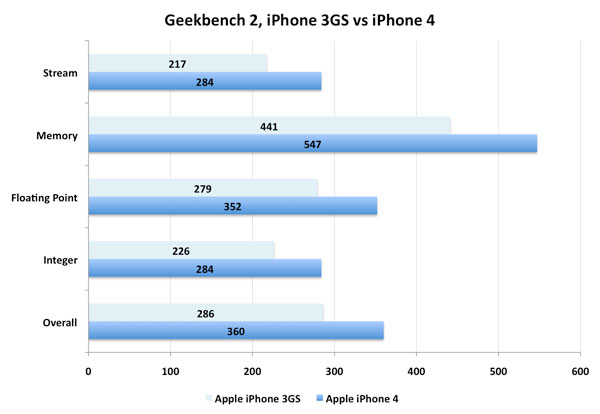
The CPU specific tests all indicate the iPhone 4 is around 25% faster than the iPhone 3GS. That would imply at least a 750MHz clock speed if all else is the same. Assuming we don’t get perfect CPU scaling with all of these tests, I’d venture a guess that 800MHz is more accurate. If the A4 does indeed have larger caches however, Apple could get away with a lower clock speed.
The memory results are particularly telling as they all scale very well going to the iPhone 4, better than the CPU results in fact. This could lend credibility to the theory of larger internal caches or perhaps to an improved (faster) memory subsystem.
Unfortunately until we get the iPad on iOS 4 we can't get a better idea of CPU scaling. I'm not even sure how reliable that will be at this point. If Apple was willing to change the amount of memory the A4 package housed between the iPad and iPhone 4, who is to say that it wouldn't have a slightly different design for the iPhone 4 (e.g. larger caches). The designs may not be physically different but we may instead be looking at binning. Given Apple's unwillingness to talk about the architecture here I think the safest bet is that we're looking at an 800MHz ARM Cortex A8 core in the iPhone 4 and a 1GHz core in the iPad.
Why the lower clock? It's all about battery life.










270 Comments
View All Comments
Brian Klug - Wednesday, June 30, 2010 - link
You know, I realized that seconds after writing it and decided that it'd just be too much to go into a detailed explanation. I corrected it to something much simpler ;)-Brian
zerosomething - Wednesday, June 30, 2010 - link
Fantastic article thanks for the in-depth review.From the article on page 5. "...iPhone capacity markings have disappeared from the back of the phone - no doubt this was done so Apple could make one part and one part only for each color."
There is actually a Model number on the back of mine. So there will need to be 4 different backs. However they can make one part for each color for the fronts. In reality they will have to make 2 fronts and 4 backs to cover all capacities and colors which is one more than they had to make for the 3G/GS phones.
Wow I'm picking such tiny nits in a fantastic article. Guess everything else was so through this one stood out.
Shadowmaster625 - Wednesday, June 30, 2010 - link
If you already own an iPhone, how is it worth it to upgrade? You said so yourself... tiny text is still tiny. So what are you getting for hundreds of dollars that the 3GS doesnt give?Guspaz - Wednesday, June 30, 2010 - link
I'm a 3GS owner in Canada (Fido is my provider), so we've had tethering ever since iOS 3.0 launched roughly a year ago. I noticed two small errors in the discussion on tethering, and felt one thing was possibly mischaracterized.First, I'd like to give a brief mention of how tethering works with Fido (and other Canadian providers). We've always had data caps on our iPhone data plans. Typically, you get something vaguely like 1GB for $30, but both the 3G and 3GS launches featured limited-time 6GB for $30 offers that are permanently grandfathered.
Fido/Rogers policy is that all users with a 1GB dataplan or higher get free tethering (this appears to be a permanent position), which uses the same data cap. So, in effect, the vast majority of Canadian iPhone owners have tethering.
The first error is "With the iOS 4 upgrades the iPhone 4 supports tethering over Bluetooth or USB." Tethering is not new in iOS 4; it's been supported since iOS 3, and tethering support is identical in iOS 4.
The second error is "You also need to either have Bluetooth enabled or be connected via USB to the computer you wish to tether." Firstly, Bluetooth doesn't need to be enabled before enabling tethering. If you enable tethering while bluetooth is disabled, a prompt appears asking you if you want to enable bluetooth, or just tether over USB. Secondly, not really an error but an important clarification: on Windows, you can only tether via USB with a computer that has the iPhone tethering drivers installed.
These tethering drivers are bundled with iTunes, and cannot normally be installed separately, but iTunes and the drivers have separate uninstallers in Add/Remove Programs. This means that you can set up, say, a friend's laptop to tether via USB by installing iTunes and then uninstalling iTunes, leaving the drivers behind. Annoying, but workable if bluetooth is unavailable.
In terms of the mischaracterization, the performance of tethering is called into question. This may be an AT&T networking issue, as I've not experienced the performance issues. Generally, whatever the networking performance my phone is achieving, a tethered computer will also achieve. There is no difference between the two, so any connectivity issues are strictly network-related rather than tethering-related. Performance is generally good; latency is usually 130-150 to a close remote host, and downstream bandwidth is 1-5 Mbps depending on congestion/location. Upstream, since the iPhone 3GS lacks HSUPA, is limited (335Kbps in practical tests), but tends not to vary quite as much as downstream based on signal quality.
Upstream performance isn't stellar, but it is relatively reliable, if a tad slow. Packetloss is rare if the phone has a good signal. I regularly use tethering to get laptops connected on the road, and remote desktop over a tethered connection is very snappy, and is amazingly faster than on-device RDP.
Mike1111 - Wednesday, June 30, 2010 - link
@Anand:"Even if you just cover the camera it’s actually better to make calls over FaceTime than 3G based on the sound quality alone."
Cover the camera? Why? Just press Home and you have a traditional voice-only VoIP call with reduced bandwidth.
Also I would like to see some comparison to the competition. Video calling on phones exists for quite some time. How about a comparison of video and voice quality?
And in regard to the bandwidth requirements, would it have been realistic to allow FaceTime over 3G?
You also mention that the compression is too high for text, is that because of a bad compression algorithm or codec, too low resolution or bandwidth? Is that something that realistically could have been done better?
strikeback03 - Thursday, July 1, 2010 - link
Does returning to the home screen actually kill the camera? That would be annoying if you only wanted to look at your calendar or something else on the phone while in a video call.Mike1111 - Thursday, July 1, 2010 - link
As with a normal (cellular) call you can always resume the video by tapping on the green status bar (call active...).Oyeve - Wednesday, June 30, 2010 - link
How is the sound quality? Is there an EQ (missing from all things "i")bkman - Wednesday, June 30, 2010 - link
An interesting review but flawed by bad metrics. The authors confuse absolute power measurement, dBm, with relative power measurement, dB. For example, a signal strength drop from -51dBm to -83dBm is not a drop of 24dBm, it is a drop of 24dB.hgoor - Wednesday, June 30, 2010 - link
Hi, I loved the review: really (and mean really) thorough! Thanks for that.However: unless I blacked out while reading and missed it: what about the noise canceling microphone? How does that work? I guess it's not that noticeable as you only mention it one time?
I'm very curious to find out if it's a feature that helps? Also: I wonder if it can be used for listening to music? I have an expensive pair of headphones from Sennheiser, but I wonder if it can be used (in the future?) to help listen to music (and on/or on the phone) when you have a lot of ambient noise?
Would be nice if you could clear that up. Also: I wonder how the iPhone 4 holds up against the new Samsung 1ghz powerhouse?
Keep up the good work!